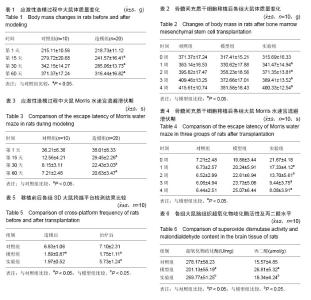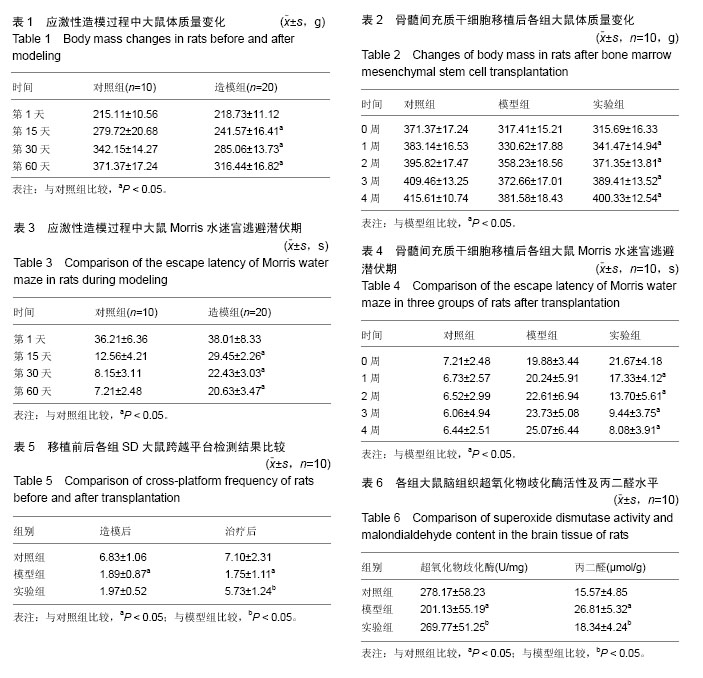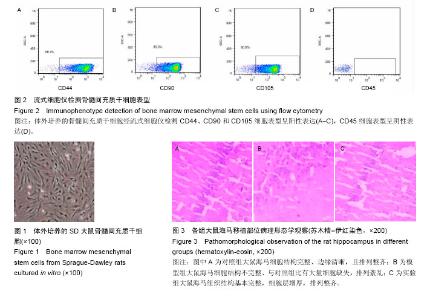Chinese Journal of Tissue Engineering Research ›› 2016, Vol. 20 ›› Issue (32): 4798-4804.doi: 10.3969/j.issn.2095-4344.2016.32.013
Previous Articles Next Articles
Effect of bone marrow mesenchymal stem cell transplantation on senile dementia behaviors
Gao Ming-long1, Sun Li2, Zhao Xiao-chuan1, Yu Ming1, Wang Jin-cheng1
- 1Department of Psychiatry, First Affiliated Hospital of Hebei Medical University, Shijiazhuang 050031, Hebei Province, China
2Department of Neurology, the 260th Hospital of Chinese PLA, Shijiazhuang 050031, Hebei Province, China
-
Revised:2016-06-30Online:2016-08-05Published:2016-08-05 -
Contact:Wang Jin-cheng, Attending physician, Department of Psychiatry, First Affiliated Hospital of Hebei Medical University, Shijiazhuang 050031, Hebei Province, China -
About author:Gao Ming-long, Master, Attending physician, Department of Psychiatry, First Affiliated Hospital of Hebei Medical University, Shijiazhuang 050031, Hebei Province, China -
Supported by:the 2014 Medical Research Project of Health and Family Planning Commission of Hebei Province of China, No. ZL20140099
CLC Number:
Cite this article
Gao Ming-long, Sun Li, Zhao Xiao-chuan, Yu Ming, Wang Jin-cheng. Effect of bone marrow mesenchymal stem cell transplantation on senile dementia behaviors[J]. Chinese Journal of Tissue Engineering Research, 2016, 20(32): 4798-4804.
share this article

2.1 实验动物数量分析 SD大鼠30只均进入最终结果分析。 2.2 各组SD大鼠体质量变化 应激性造模第1天,各组SD大鼠的体质量差异无显著性意义(P > 0.05);在应激造模的第15,30,60天,与对照组大鼠比,造模SD大鼠平均体质量偏低,差异有显著性意义(P < 0.05),结果见表1。骨髓间充质干细胞移植后0周,实验组与模型组比较,体质量差异无显著性意义(P > 0.05);骨髓间充质干细胞移植后1,2,3,4周,实验组体质量明显高于模型组,差异有显著性意义(P < 0.05),实验组大鼠体质量越来越接近于对照组,结果见表2。 2.3 各组SD大鼠Morris水迷宫逃避潜伏期测定结果 应激性造模第1天,各组大鼠平均逃避潜伏期差异无显著性意义(P > 0.05),造模第15天,对照组及造模组大鼠逃避潜伏期均明显下降,第30-60天,与对照组相比,造模组的逃避潜伏期均明显较长,差异有显著性意义 (P < 0.05),见表3。骨髓间充质干细胞移植后0周,实验组与模型组比较,大鼠逃避潜伏期差异无显著性意义(P > 0.05)。移植1,2,3,4周,实验组与模型组比较,实验组平均逃避潜伏期迅速下降,差异有显著性意义 (P < 0.05),同时实验组大鼠逃避潜伏期越来越接近于对照组,见表4。 2.4 各组大鼠Morris水迷宫跨越平台检测结果 与对照组相比,造模成功后SD大鼠跨越平台次数明显减少,差异有显著性意义(P < 0.05);骨髓间充质干细胞移植后1周,模型组SD大鼠跨越平台次数并没有显著变化,对照组大鼠跨越平台次数略有增加,模型组与对照组比差异有显著性意义(P < 0.05);实验组与模型组比较,跨越平台次数明显增多,差异有显著性意义(P < 0.05),但跨越平台次数仍低于对照组,与对照组比较,差异也有显著性意义(P < 0.05),见表5。 2.5 各组大鼠脑组织超氧化物歧化酶活性及丙二醛水平 与对照组比,模型组大鼠脑组织中超氧化物歧化酶活性显著降低(P < 0.05),而丙二醛水平却明显升高(P < 0.05)。骨髓间充质干细胞移植后,与模型组比较,实验组脑组织中超氧化物歧化酶活性升高(P < 0.05),丙二醛水平减少(P < 0.05),与对照组大鼠脑组织中超氧化物歧化酶活性及丙二醛水平相近,见表6。 2.6 体外培养的骨髓间充质干细胞形态 分离培养4 h细胞即开始逐渐贴壁,由圆形逐渐变为长梭形(图1)。经流式细胞仪检测CD44、CD90和CD105细胞表型呈阳性表达,CD45细胞表型呈阴性表达(图2),所分离出的细胞符合骨髓间充质干细胞的形态及表面标志物等特性,具有较好的自我更新能力和多向分化潜能,证实分离所得细胞为骨髓间充质干细胞。 2.7 各组大鼠海马移植部位病理形态学观察 对照组大鼠海马细胞结构完整、边缘清晰,细胞层厚、密度大,且排列整齐、紧密(图3A);模型组大鼠海马细胞结构不完整、与对照组比有大量细胞缺失,细胞层变薄,间隙增大,排列紊乱、疏松(图3B);实验组骨髓间充质干细胞移植4周后,大鼠海马组织结构基本完整,与模型组比,细胞层增厚,排列整齐(图3C)。"

| [1] Howard KL, Filley CM. Advances in genetic testing for Alzheimer's disease. Rev Neurol Dis. 2009;6(1):26-32. [2] Salminen A, Ojala J, Kauppinen A, et al. Inflammation in Alzheimer's disease: amyloid-beta oligomers trigger innate immunity defence via pattern recognition receptors. Prog Neurobiol. 2009;87(3):181-194. [3] Jakob-Roetne R, Jacobsen H. Alzheimer's disease: from pathology to therapeutic approaches. Angew Chem Int Ed Engl. 2009;48(17):3030-3059. [4] Buckingham SD, Jones AK, Brown LA, et al. Nicotinic acetylcholine receptor signalling: roles in Alzheimer's disease and amyloid neuroprotection. Pharmacol Rev. 2009;61(1):39-61. [5] Lovell MA. A potential role for alterations of zinc and zinc transport proteins in the progression of Alzheimer's disease. J Alzheimers Dis. 2009;16(3): 471-483. [6] Deane R, Bell RD, Sagare A, et al. Clearance of amyloid-beta peptide across the blood-brain barrier: implication for therapies in Alzheimer's disease. CNS Neurol Disord Drug Targets. 2009;8(1):16-30. [7] Saxena U. Lipid metabolism and Alzheimer's disease: pathways and possibilities. Expert Opin Ther Targets. 2009;13(3):331-338. [8] 张翼.中国老年人口的家庭居住健康与照料安排第六次人口普查数据分析[J].江苏社科学,2013(1):57-65. [9] 樊清华,郑建中.老年痴呆患病率及危险因素调查[J].现代预防医学,2011,38(15):3029-3033. [10] Prockop DJ. Marrow stromal cells as stem cells for nonhematopoietic tissues. Science. 1997;276(5309): 71-74. [11] Friedenstein AJ, Gorskaja JF, Kulagina NN. Fibroblast precursors in normal and irradiated mouse hematopoietic organs. Exp Hematol. 1976;4(5):267- 274. [12] Castro-Malaspina H, Gay RE, Resnick G, et al. Characterization of human bone marrow fibroblast colony-forming cells (CFU-F) and their progeny. Blood. 1980;56(2):289-301. [13] Bab I, Ashton BA, Gazit D, et al. Kinetics and differentiation of marrow stromal cells in diffusion chambers in vivo. J Cell Sci. 1986;84:139-151. [14] 中华人民共和国科学技术部.关于善待实验动物的指导性意见.2006-09-30. [15] Gotloib LC,Shostak A,Gotloib L. Behavioral Changes in Mice Induced by Aluminum in Drinking Water. Dementia & Geriatric Cognitive Disorders. 1991; 2(5): 278-282. [16] 张魁华,赖世隆,王奇,等.补肾益智方对老年性痴呆模型动物空间探索学习记忆功能的改善作用[J].中草药,2002, 33(12):1093-1095. [17] Morris RG, Garrud P, Rawlins JN, et al. Place navigation impaired in rats with hippocampal lesions. Nature. 1982;297(5868):681-683. [18] Götherström C, Ringdén O, Tammik C, et al. Immunologic properties of human fetal mesenchymal stem cells. Am J Obstet Gynecol. 2004;190(1): 239-245. [19] 徐如祥.阿尔茨海默病的分子机制与神经干细胞移植治疗[J].老年医学与保健,2004,10(3):177-180. [20] Masters CL, Beyreuther K,Henryk M. Wisniewski and the amyloid theory of Alzheimer's disease. J Alzheimers Dis. 2001;3(1):83-86. [21] Lewis J, McGowan E, Rockwood J, et al. Neurofibrillary tangles, amyotrophy and progressive motor disturbance in mice expressing mutant (P301L) tau protein. Nat Genet. 2000;25(4):402-405. [22] de la Torre JC. Critically attained threshold of cerebral hypoperfusion: can it cause Alzheimer's disease. Ann N Y Acad Sci. 2000;903:424-436. [23] Tanimukai H, Grundke-Iqbal I, Iqbal K. Up-regulation of inhibitors of protein phosphatase-2A in Alzheimer's disease. Am J Pathol. 2005;166(6):1761-1771. [24] Ballatore C, Lee VM, Trojanowski JQ. Tau-mediated neurodegeneration in Alzheimer's disease and related disorders. Nat Rev Neurosci. 2007;8(9):663-672. [25] Li Y, Qin HQ, Chen QS, et al. Neurochemical and behavioral effects of the intrahippocampal co-injection of beta-amyloid protein1-40 and ibotenic acid in rats. Life Sci. 2005;76(11):1189-1197. [26] Rosato-Siri M, Cattaneo A, Cherubini E. Nicotine- induced enhancement of synaptic plasticity at CA3-CA1 synapses requires GABAergic interneurons in adult anti-NGF mice. J Physiol. 2006;576(Pt 2): 361-377. [27] Redei EE, Ahmadiyeh N, Baum AE, et al. Novel animal models of affective disorders. Semin Clin Neuropsychiatry. 2001;6(1):43-67. [28] Duman RS. Pathophysiology of depression: the concept of synaptic plasticity. Eur Psychiatry. 2002;17 Suppl 3:306-310. [29] Wang XY, Chen J, Zhang JT. Effect of ginsenoside Rg1 on learning and memory impairment induced by beta-amyloid peptide(25-35) and its mechanism of action.Yao Xue Xue Bao. 2001;36(1):1-4. [30] Lee JK, Jin HK, Bae JS. Bone marrow-derived mesenchymal stem cells reduce brain amyloid-beta deposition and accelerate the activation of microglia in an acutely induced Alzheimer's disease mouse model. Neurosci Lett. 2009;450(2):136-141. [31] Woodbury D, Schwarz EJ, Prockop DJ, et al. Adult rat and human bone marrow stromal cells differentiate into neurons. J Neurosci Res. 2000;61(4):364-370. [32] Cho JS, Park HW, Park SK, et al. Transplantation of mesenchymal stem cells enhances axonal outgrowth and cell survival in an organotypic spinal cord slice culture. Neurosci Lett. 2009;454(1):43-48. [33] Kitada M, Dezawa M. Induction system of neural and muscle lineage cells from bone marrow stromal cells; a new strategy for tissue reconstruction in degenerative diseases. Histol Histopathol. 2009;24(5):631-642. [34] Lee JK, Jin HK, Bae JS. Bone marrow-derived mesenchymal stem cells attenuate amyloid β-induced memory impairment and apoptosis by inhibiting neuronal cell death. Curr Alzheimer Res. 2010;7(6): 540-548. [35] Biswas SC, Shi Y, Vonsattel JP, et al. Bim is elevated in Alzheimer's disease neurons and is required for beta-amyloid-induced neuronal apoptosis. J Neurosci. 2007;27(4):893-900. [36] Cummings JL. Alzheimer's disease. N Engl J Med. 2004;351(1):56-67. [37] Rosen WG, Mohs RC, Davis KL. A new rating scale for Alzheimer's disease. Am J Psychiatry. 1984;141(11): 1356-1364. [38] Wu QY, Li J, Feng ZT, et al. Bone marrow stromal cells of transgenic mice can improve the cognitive ability of an Alzheimer's disease rat model. Neurosci Lett. 2007; 417(3):281-285. [39] Dezawa M. Systematic neuronal and muscle induction systems in bone marrow stromal cells: the potential for tissue reconstruction in neurodegenerative and muscle degenerative diseases. Med Mol Morphol. 2008;41(1): 14-19. [40] Yaghoobi MM, Mowla SJ. Differential gene expression pattern of neurotrophins and their receptors during neuronal differentiation of rat bone marrow stromal cells. Neurosci Lett. 2006;397(1-2):149-154. [41] Hermann A, Maisel M, Storch A. Epigenetic conversion of human adult bone mesodermal stromal cells into neuroectodermal cell types for replacement therapy of neurodegenerative disorders. Expert Opin Biol Ther. 2006;6(7):653-670. |
| [1] | Zhang Tongtong, Wang Zhonghua, Wen Jie, Song Yuxin, Liu Lin. Application of three-dimensional printing model in surgical resection and reconstruction of cervical tumor [J]. Chinese Journal of Tissue Engineering Research, 2021, 25(9): 1335-1339. |
| [2] | Wang Shiqi, Zhang Jinsheng. Effects of Chinese medicine on proliferation, differentiation and aging of bone marrow mesenchymal stem cells regulating ischemia-hypoxia microenvironment [J]. Chinese Journal of Tissue Engineering Research, 2021, 25(7): 1129-1134. |
| [3] | Zeng Yanhua, Hao Yanlei. In vitro culture and purification of Schwann cells: a systematic review [J]. Chinese Journal of Tissue Engineering Research, 2021, 25(7): 1135-1141. |
| [4] | Hou Jingying, Yu Menglei, Guo Tianzhu, Long Huibao, Wu Hao. Hypoxia preconditioning promotes bone marrow mesenchymal stem cells survival and vascularization through the activation of HIF-1α/MALAT1/VEGFA pathway [J]. Chinese Journal of Tissue Engineering Research, 2021, 25(7): 985-990. |
| [5] | Liang Xueqi, Guo Lijiao, Chen Hejie, Wu Jie, Sun Yaqi, Xing Zhikun, Zou Hailiang, Chen Xueling, Wu Xiangwei. Alveolar echinococcosis protoscolices inhibits the differentiation of bone marrow mesenchymal stem cells into fibroblasts [J]. Chinese Journal of Tissue Engineering Research, 2021, 25(7): 996-1001. |
| [6] | Geng Yao, Yin Zhiliang, Li Xingping, Xiao Dongqin, Hou Weiguang. Role of hsa-miRNA-223-3p in regulating osteogenic differentiation of human bone marrow mesenchymal stem cells [J]. Chinese Journal of Tissue Engineering Research, 2021, 25(7): 1008-1013. |
| [7] | Lun Zhigang, Jin Jing, Wang Tianyan, Li Aimin. Effect of peroxiredoxin 6 on proliferation and differentiation of bone marrow mesenchymal stem cells into neural lineage in vitro [J]. Chinese Journal of Tissue Engineering Research, 2021, 25(7): 1014-1018. |
| [8] | Zhu Xuefen, Huang Cheng, Ding Jian, Dai Yongping, Liu Yuanbing, Le Lixiang, Wang Liangliang, Yang Jiandong. Mechanism of bone marrow mesenchymal stem cells differentiation into functional neurons induced by glial cell line derived neurotrophic factor [J]. Chinese Journal of Tissue Engineering Research, 2021, 25(7): 1019-1025. |
| [9] | Pei Lili, Sun Guicai, Wang Di. Salvianolic acid B inhibits oxidative damage of bone marrow mesenchymal stem cells and promotes differentiation into cardiomyocytes [J]. Chinese Journal of Tissue Engineering Research, 2021, 25(7): 1032-1036. |
| [10] | Xu Dongzi, Zhang Ting, Ouyang Zhaolian. The global competitive situation of cardiac tissue engineering based on patent analysis [J]. Chinese Journal of Tissue Engineering Research, 2021, 25(5): 807-812. |
| [11] | Chen Junyi, Wang Ning, Peng Chengfei, Zhu Lunjing, Duan Jiangtao, Wang Ye, Bei Chaoyong. Decalcified bone matrix and lentivirus-mediated silencing of P75 neurotrophin receptor transfected bone marrow mesenchymal stem cells to construct tissue-engineered bone [J]. Chinese Journal of Tissue Engineering Research, 2021, 25(4): 510-515. |
| [12] | Wu Zijian, Hu Zhaoduan, Xie Youqiong, Wang Feng, Li Jia, Li Bocun, Cai Guowei, Peng Rui. Three-dimensional printing technology and bone tissue engineering research: literature metrology and visual analysis of research hotspots [J]. Chinese Journal of Tissue Engineering Research, 2021, 25(4): 564-569. |
| [13] | Chang Wenliao, Zhao Jie, Sun Xiaoliang, Wang Kun, Wu Guofeng, Zhou Jian, Li Shuxiang, Sun Han. Material selection, theoretical design and biomimetic function of artificial periosteum [J]. Chinese Journal of Tissue Engineering Research, 2021, 25(4): 600-606. |
| [14] | Liu Fei, Cui Yutao, Liu He. Advantages and problems of local antibiotic delivery system in the treatment of osteomyelitis [J]. Chinese Journal of Tissue Engineering Research, 2021, 25(4): 614-620. |
| [15] | Li Xiaozhuang, Duan Hao, Wang Weizhou, Tang Zhihong, Wang Yanghao, He Fei. Application of bone tissue engineering materials in the treatment of bone defect diseases in vivo [J]. Chinese Journal of Tissue Engineering Research, 2021, 25(4): 626-631. |
| Viewed | ||||||
|
Full text |
|
|||||
|
Abstract |
|
|||||

